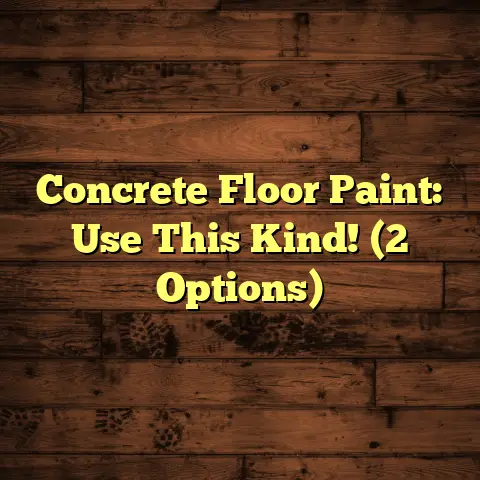Tile And Wood Floors: Ideas? (7 Style Must-Sees!)
Different rooms have totally different needs. A kitchen floor needs to be able to handle spills and splashes, while a living room needs to feel warm and inviting.
That’s where tile and wood come in. They’re both fantastic options, but they shine in different ways.
Let’s dive into how to pick the perfect flooring for each room, and then I’ll share seven of my favorite style ideas that blend tile and wood beautifully!
Section 1: Understanding Room-Specific Needs
1.1 Living Room Needs
The living room is the heart of the home. It’s where you relax, entertain, and spend quality time with family. So, comfort and style are key.
Wood floors are a classic choice for living rooms. They add warmth, character, and a touch of elegance. Think about a cozy evening by the fireplace on a beautiful hardwood floor. Can you picture it?
Tile can also work in a living room, especially if you’re going for a sleek, modern vibe. Large-format tiles can create a seamless look and make the space feel bigger.
Durability is also important. Living rooms see a lot of foot traffic, so you’ll want a floor that can stand up to wear and tear.
Easy maintenance is a must. Nobody wants to spend hours cleaning their living room floor. I always recommend considering the finish of the wood or the type of tile to minimize maintenance.
1.2 Kitchen Needs
Kitchens are busy places! Spills, splatters, and dropped dishes are all part of the daily grind. Water resistance and ease of cleaning are essential.
Tile is a fantastic choice for kitchens. Ceramic and porcelain tiles are incredibly durable, water-resistant, and easy to clean. Plus, they come in a huge range of styles and colors.
Wood can work in kitchens, but you need to be careful. Engineered wood is a better option than solid hardwood because it’s more resistant to moisture. You’ll also want to make sure it’s properly sealed.
I’ve seen some stunning kitchens that combine wood cabinets with tile floors. The key is to choose a design that complements both the cabinetry and the appliances.
Did you know? According to the National Kitchen and Bath Association (NKBA), tile is the most popular flooring choice for kitchens, with about 60% of homeowners choosing it.
1.3 Bathroom Needs
Bathrooms are all about moisture resistance and slip resistance. Water is everywhere, so you need a floor that can handle it.
Tile is the obvious choice for bathrooms. Ceramic and porcelain tiles are waterproof and come in a variety of textures that can help prevent slips.
Wood is not ideal for bathrooms. Even with proper sealing, it can still be damaged by moisture over time. If you really want the look of wood, consider a wood-look tile.
I’ve seen some amazing bathrooms that combine different types of tile. You could use a textured tile on the floor for slip resistance and a decorative tile on the walls for visual interest.
Mixing tile and wood elements can also work. For example, you could have a tile floor with a wood vanity.
1.4 Bedroom Needs
Bedrooms should be cozy, inviting, and relaxing. You want a floor that feels good under your feet and creates a sense of warmth.
Wood flooring is a great choice for bedrooms. It adds warmth, character, and a touch of luxury. Imagine waking up in the morning and stepping onto a soft, warm wood floor.
Tile can work in bedrooms, but it can feel a bit cold and sterile. If you go with tile, I recommend adding area rugs to soften the space and add warmth.
I often suggest to my clients to add area rugs and accents to enhance comfort and style. A plush rug next to the bed can make all the difference.
1.5 Dining Room Needs
Dining rooms need a floor that’s both stylish and durable. It’s a space where you entertain guests, so you want it to look good. But it’s also a space where spills are likely to happen, so you need something that’s easy to clean.
Different flooring options can really influence the ambiance of dinner parties and family gatherings. A beautiful wood floor can create a warm and inviting atmosphere, while a sleek tile floor can feel more modern and sophisticated.
I’ve seen some really cool dining rooms that blend tile and wood. For example, you could have a wood floor in the main dining area and a tile border around the perimeter.
1.6 Hallway Needs
Hallways are high-traffic areas that need to withstand a lot of wear and tear. Durability is key.
Tile and wood combinations can work really well in hallways. Tile is a great choice for the entryway, where people are likely to track in dirt and water. Wood can then be used in the rest of the hallway to add warmth and character.
I always pay close attention to transitions between rooms. You want the flooring to flow seamlessly from one space to the next.
1.7 Outdoor Spaces
Extending flooring styles outdoors is a growing trend. People want to create a seamless indoor-outdoor flow.
Porcelain tile is a fantastic choice for outdoor spaces. It’s durable, weather-resistant, and comes in a variety of styles that mimic natural stone or wood.
Treated wood can also be used outdoors, but it requires regular maintenance to prevent rot and decay.
I’ve designed some amazing outdoor patios that use the same tile as the indoor flooring. This creates a really cohesive look and makes the space feel like an extension of the home.
Section 2: The Must-Sees: 7 Stylish Ideas for Tile and Wood Floors
Okay, now for the fun part! Here are seven of my favorite style ideas that blend tile and wood beautifully.
2.1 Idea 1: Herringbone Patterns
Herringbone patterns are a classic choice that add elegance and sophistication to any room.
You can use herringbone patterns in wood to create a timeless look. It’s especially popular in living rooms and dining rooms.
Tile can also mimic this pattern for a cohesive look. I’ve seen some stunning tile herringbone patterns in bathrooms and kitchens.
Pro Tip: Consider using a contrasting grout color to really make the herringbone pattern pop.
2.2 Idea 2: Mixed Material Designs
Combining wood and tile in a single space is a bold move that can pay off big time. It adds visual interest and creates a unique, custom look.
Entryways are a great place to mix wood and tile. You could use tile in the entryway to handle dirt and water and then transition to wood in the rest of the house.
Dining areas are another good option. You could have a wood floor in the main dining area and a tile border around the perimeter.
Think about it: How can you use different materials to define different zones within a single space?
2.3 Idea 3: Large Format Tiles
Large format tiles are all the rage right now. They create a seamless, modern look and make the space feel bigger.
Compared to wood flooring, large format tiles can be a more budget-friendly option. They also require less grout, which means less maintenance.
The size of the tile can really affect the perception of space. Larger tiles can make a small room feel bigger, while smaller tiles can make a large room feel more intimate.
I’ve found that: Clients are often surprised at how much of a difference the size of the tile can make.
2.4 Idea 4: Color Contrast
Using contrasting colors in wood and tile is a simple way to create visual interest.
For example, you could pair a light wood floor with dark tile accents. Or, you could pair a dark wood floor with light tile accents.
Successful color palettes often involve a neutral base with pops of color. Think about using a gray tile with a warm wood tone.
Don’t be afraid to experiment! Try out different color combinations to see what you like best.
2.5 Idea 5: Textured Surfaces
Textured tiles and distressed wood add character and depth to a room. They also enhance tactile experiences.
Textured tiles are great for bathrooms because they provide extra slip resistance. Distressed wood adds a rustic, lived-in feel to living rooms and bedrooms.
These elements can really enhance the tactile experience in rooms. Imagine running your hand across a textured tile wall or feeling the grain of distressed wood under your feet.
Pro Tip: Consider using textured surfaces in areas where you want to create a focal point.
2.6 Idea 6: Eco-Friendly Options
Sustainable materials are becoming increasingly popular in flooring. People want to choose options that are good for the environment.
For tile, look for recycled content or locally sourced materials. For wood, look for FSC-certified wood, which means it comes from sustainably managed forests.
Innovative products are combining aesthetics with environmental responsibility. For example, there are tiles made from recycled glass and wood flooring made from reclaimed timber.
I’m seeing more and more clients who are specifically asking for eco-friendly flooring options.
2.7 Idea 7: Custom Inlays and Borders
Custom inlays and borders are a fantastic way to elevate flooring to a statement piece. They add a touch of artistry and create a truly unique look.
You can use tile and wood to create stunning custom inlays. For example, you could create a mosaic pattern in the entryway or a geometric border around the dining room.
Think of your floor as a blank canvas. What kind of design would you create?
I love working with clients to design custom inlays that reflect their personal style.
Conclusion
So, there you have it! Choosing the right flooring style is essential to meet the functional and aesthetic needs of different rooms.
I hope this article has given you some inspiration and ideas for your own home. Remember to consider your unique spaces and how tile and wood floors can transform your home into a stylish, comfortable environment.
Don’t be afraid to experiment and have fun with it! After all, your floors are a reflection of your personal style.





